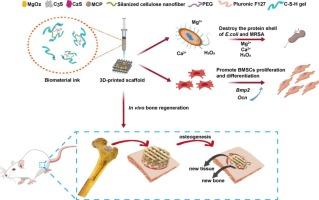3d打印过氧化镁掺杂磷酸硅酸钙支架翻修全膝关节置换术的体外抗菌和体内成骨作用
IF 7.9
2区 材料科学
Q1 MATERIALS SCIENCE, MULTIDISCIPLINARY
引用次数: 0
摘要
改良全膝关节置换术(RTKA)常出现胫骨缺损,感染风险高,尤其是耐甲氧西林金黄色葡萄球菌(MRSA)感染风险高。目前的策略依赖于带抗生素的骨移植,但长期使用会促进耐药性。在这里,我们开发了一种3d打印的氧化镁(MgO2)掺杂磷酸硅酸钙(CSP)支架,以满足结构和抗菌需求。MgO2-CSP支架具有松质骨样强度(约7.95 MPa)和相互连接的大孔结构,有利于细胞迁移和愈合。体外,14wt % MgO2支架(B14M)通过Mg2+和H2O2释放抑制80.4%的革兰氏阴性菌和74.6%的MRSA,而B0M(不含MgO2)和B14M均促进BMSC增殖和成骨分化。在体内,B14M支架显著增强了大鼠胫骨缺损的骨再生,8周时B14M的BV/TV为73.09%,而B14M的BV/TV为29.84%。这些发现突出了MgO2-CSP支架作为一种有希望的策略,在对抗mrsa相关感染的同时促进骨生成。本文章由计算机程序翻译,如有差异,请以英文原文为准。

In vitro antibacterial and In vivo osteogenesis of 3D-printed magnesium peroxide–doped calcium phosphate silicate scaffolds for revision total knee arthroplasty
Revision total knee arthroplasty (RTKA) often encounters tibial bone defects and high infection risk, especially from methicillin-resistant Staphylococcus aureus (MRSA). Current strategies rely on bone grafts with antibiotics, but prolonged use promotes resistance. Here, we developed a 3D-printed magnesium peroxide (MgO2)–doped calcium phosphate silicate (CSP) scaffold to address both structural and antibacterial demands. The MgO2–CSP scaffold exhibited cancellous bone-like strength (∼7.95 MPa) and an interconnected macroporous structure conducive to cell migration and healing. In vitro, the 14 wt% MgO2 scaffold (B14M) inhibited 80.4 % of Gram-negative bacteria and 74.6 % of MRSA via Mg2+ and H2O2 release, while both B0M (no MgO2) and B14M promoted BMSC proliferation and osteogenic differentiation. In vivo, the B14M scaffold markedly enhanced bone regeneration in rat tibial defects, achieving a BV/TV of ∼73.09 % versus ∼29.84 % for B0M at 8 weeks. These findings highlight MgO2–CSP scaffolds as a promising strategy to promote osteogenesis while combating MRSA-associated infections in RTKA.
求助全文
通过发布文献求助,成功后即可免费获取论文全文。
去求助
来源期刊

Materials & Design
Engineering-Mechanical Engineering
CiteScore
14.30
自引率
7.10%
发文量
1028
审稿时长
85 days
期刊介绍:
Materials and Design is a multi-disciplinary journal that publishes original research reports, review articles, and express communications. The journal focuses on studying the structure and properties of inorganic and organic materials, advancements in synthesis, processing, characterization, and testing, the design of materials and engineering systems, and their applications in technology. It aims to bring together various aspects of materials science, engineering, physics, and chemistry.
The journal explores themes ranging from materials to design and aims to reveal the connections between natural and artificial materials, as well as experiment and modeling. Manuscripts submitted to Materials and Design should contain elements of discovery and surprise, as they often contribute new insights into the architecture and function of matter.
 求助内容:
求助内容: 应助结果提醒方式:
应助结果提醒方式:


